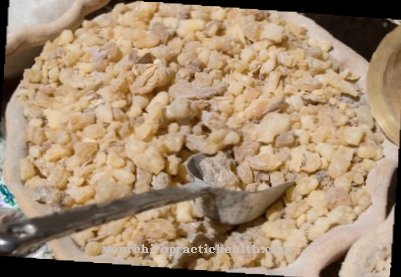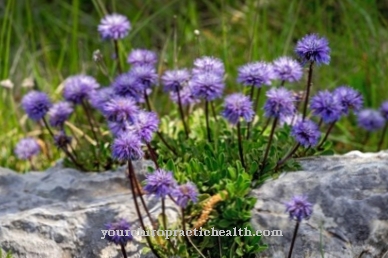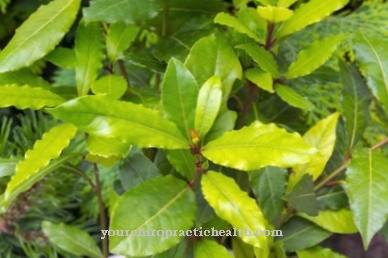The Citric root is a plant from the ginger family that is native to Southeast Asia. The dried root of the plant is mainly used as a medicine in China and Japan. Zitwer root is also known as a medicinal plant in traditional European medicine.
Occurrence and cultivation of the lemon root

During the flowering period, the plant has green bracts and yellow flowers. The rhizome is edible. It's white and has a mango or ginger-like scent. The aftertaste is rather bitter. The whole plant gives off a very strong scent. There is a risk of confusion with the German name Zitwer.
In addition to the Asian lemon root described in this text, the lemon blossom is also known. However, this does not come from Curcuma cedoaria, but from a poisonous Russian mugwort plant, the worm seed (Artemisia cina). In Russian folk medicine, the citrus flowers were used as a wormer. In Germany, the calamus is also sometimes referred to as the German Zitwer.
Effect & application
Essential oils and resin acids are essential components of citric root. These give the root its aromatic scent and slightly pungent taste. The rhizome of the plant also contains zingiberen, zingiberol and shogaol. Pungent substances, sesquiterpenes, mucus and bitter substances are also contained in lemon root. The roots also have vitamin C, magnesium, calcium, potassium, sodium, phosphorus and iron.
The bitter substances and the essential oils of the plant ensure a digestive effect. Similar to its relatives ginger and turmeric, citrus root also stimulates the production of digestive juices and strengthens the liver. The passage of food in the intestine is accelerated by the increased secretion of digestive enzymes. In addition, the increased amount of bile acids released from food binds fats. This makes fatty food easier to digest. The citric root relieves gas and bloating and can also have a regulating effect when cholesterol levels are too high.
The bile not only binds fats, but also toxins and pollutants from the liver. These can now also be eliminated more easily. Similar to turmeric, citrus root is said to have a positive influence on blood sugar levels. There is also an effect on the blood vessels and blood pressure. The citrus root has a slight antihypertensive effect and also acts as an antagonist to arachidonic acid, which can cause inflammation on the vessel walls. This means that the citrus root is also a preventive agent against arteriosclerosis.
Furthermore, the root also has a positive effect on the heart and can be used in conjunction with heart failure. The dried roots of the plant are used medicinally. For a tea made from lemon root, a teaspoon of the dried rhizome is poured over boiling water. In order for all the ingredients from the tea drug to pass into the liquid, the infusion must steep for fifteen minutes. The citrus root can be easily combined with other digestive and liver-strengthening tea drugs such as dandelion, chamomile flowers or peppermint leaves.
Alternatively, a tincture can be made with the root. Simply fill a mason jar halfway with dried lemon root and pour a high-percentage clear schnapps over it until the glass is completely filled. The glass should be in a sunny, warm place for about four weeks and should be shaken from time to time. The tincture can then be filtered and poured into a dark bottle. Ten to fifty drops of the lemon root tincture should be taken three times a day.
Importance for health, treatment & prevention
In Japan and China, the citrus root is very popular as a remedy. There it is part of many traditional tea blends that are prescribed by Chinese and Japanese doctors for various complaints. In Germany, lemon root was included in the German Pharmacopoeia (DAB) in 1962. In 1988 the citrus root was examined for its effectiveness by an expert commission for herbal medicines on behalf of the German Federal Institute for Drugs and Medical Devices.
The commission concluded that the medicinal properties of the plant could not be scientifically proven. Zitwerwurzel received a so-called negative monograph and was no longer included in the tenth edition of the German Pharmacopoeia, which appeared in 1991. The plants Curcuma longa and Curcuma xanthorrhiza, which are very closely related to the citrus root, have been part of the German Pharmacopoeia since 1930 and 1978 respectively.
The essential oil of the citrus root is still used in liqueur production in western countries. The essential oil is also used in the perfume industry. As a spice, the lemon root does not play an important role in Germany. In India it is often used for pickling vegetables and fruit and is also part of curry pastes. In Thailand the young rhizomes are consumed as vegetables.
Although the citrus root is not significantly inferior to the curcuma root and ginger in terms of its medicinal properties, the plant is rather unknown both as a medicinal product and as a spice in Germany and is only rarely used medicinally.
























.jpg)



